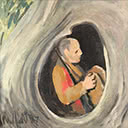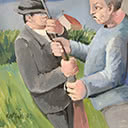George S. Ridley Attempts to Disarm Graham - From the Stanley Graham Series
58 x 58 cm
PROVENANCE
Private Collection, Auckland
The exhibition was reviewed in the Otago Daily Times by John Reid, Jr. Of Moffitt's works he noted: ... the Stanley Graham tragedy. This incident has become folklore in New Zealand and the subject of intense interest. Perhaps he represents some archetypal New Zealand character - violent, depressed and very alone. Action or the immediate moments before and after are Moffitt's subjects. (I'll blow your bloody guts out all over the grass). ... They are disturbing paintings of mad stretched moments of agony. In November, the major part of the Stan Graham Series was exhibited at the Louise Beale Gallery, that had become Trevor's dealer gallery of choice. Moffitt sent up thirty works, four priced at $3,000 and the rest at $1,500, although six of these had already been sold direct from the artist. However, Trevor put these sales through Louise's gallery and she was most appreciative of this.
Trevor travelled up for the show and was delighted when Sue Mercer, arriving back in New Zealand after a year overseas, flew direct from Auckland to attend the opening as a surprise. Considering the lack of sales of the small sample exhibited in Dunedin, Moff was happily astonished that all but six of the works had been sold by the time the Wellington show closed. However, this success did have its corollary. It produced a tax bill of about $16,000 and as Trevor retired from teaching the month after the exhibition, it did affect what appeared to be a buoyant situation, particularly as he did not sell another painting until the second half of 1988. Although, at this time, the fallout from the October 1987 share market crash was being felt throughout the country.
The Evening Post interviewed Moffitt about the series but did not review the paintings. Trevor said that following the death of Alison: ... he had empathy for Graham. The whole world fell on his head, with one event building on top of another. Graham sought pleasure through violence. He bred fighting cocks.
It was [Moffitt] said, interesting to note that all the people shot by Graham were killed on Graham's own property. He believed Graham had a strong drive to defend what was his. For some, the resurrection of the Graham saga unearthed bad memories ... 'It was an emotional experience for a lot of people', .... He had spoken on the telephone to a relative of Graham's wife, who asked why he was 'raking it up'. At a later date, Terry McNamara for the New Zealand Herald, commented: ... [The] image of Graham carried on a farm gate, his eyes rolling in agony and lunacy. It is unforgettable. This is more than illustration, it is a monumental painting of the end of an outlaw and the beginning of a legend.
Back in Christchurch, Allison Gregory interviewed Trevor for an article in the Christchurch Star in mid December: 'I felt an empathy for him. Things were stacked up against him'... 51 oil paintings, roughly a chronological description of Graham's lifestyle leading into the shootings and manhunt. 'The narrative was important - how Graham was and how his life got out of control. Moffitt did a series ... Mackenzie the sheep rustler. Both Mackenzie and Graham impressed him not as heroes, but as individuals whose contribution to New Zealand history was worthy of record. Graham in particular was as much a victim as the people he shot, Moffitt said. 'The lessons of the man are still to be learnt - that lack of communication leads to violence in society'. I've been tryin to disguise myself as Arkwright the grocer for years'.





